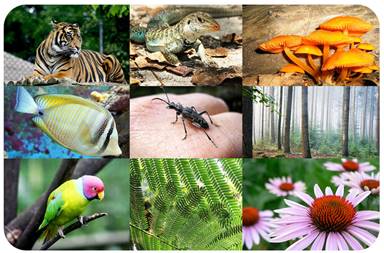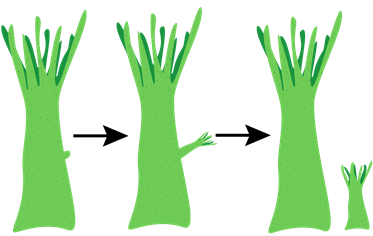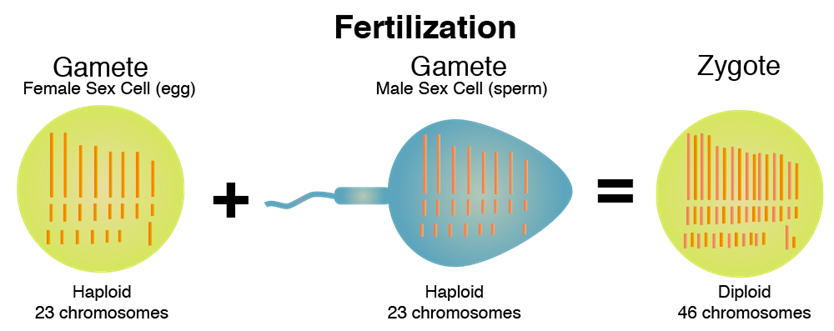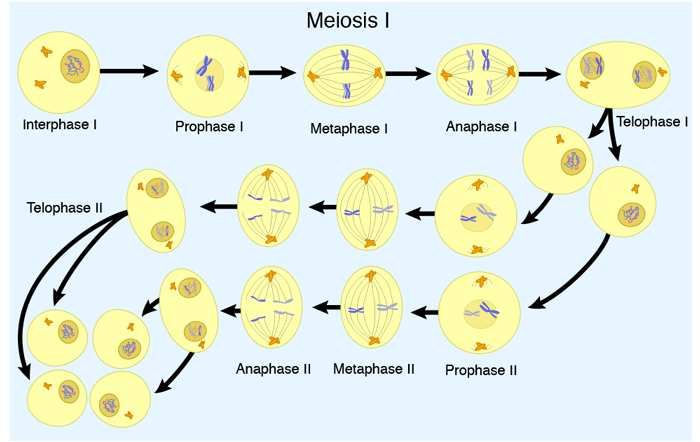The
Beginning of Life
Reproduction occurs when an organism (living thing) makes a copy of DNA and produces an offspring.
All living things on Earth are a process of reproduction.
To
better understand the reproduction of living things, click the image above.
Introduction
You have learned that parents pass on their
traits to their offspring. But how does that happen?
In this unit, you will explore how plants and
animals reproduce differently. You will see how some organisms form new
offspring from one parent while others create new offspring from two
parents—and some can do both.

Life on Earth is possible because plants,
animals, and other organisms can reproduce. But what does it mean to reproduce?
Reproduction is the ability to make
a copy of something. In biology, it is the process of forming new offspring.
Reproduction is one of the basic characteristics of life, and it is why new
life is possible.
There are two ways to reproduce:
- Asexual reproduction forms new offspring from
one parent
- Type
of reproduction in which a new organism is produced from one parent
- The
offspring is identical to the parent.
- It
occurs in most plants, bacteria, protists, and invertebrates
- Sexual reproduction forms new offspring from
two parents
- Type
of reproduction in which a new organism is produced from two parents.
- Offspring
is a combination of both parents.
- Offspring
are different from each parent
In your science
journal,
watch the video above and answer the questions.
1.
Why do offspring sometimes look similar to their parents and
sometimes look different?
2.
What is the difference
between sexual and asexual reproduction?
3.
What are some examples of
animal adaptations for improving their chances of reproduction and offspring
survival?
Asexual
Reproduction
In most organisms that reproduce asexually,
the single parent passes on its genetic material to its offspring to make an exact
copy of itself. That can be a problem if the parent has a gene that causes a
particular disease because the offspring will also have that gene.
Only one parent is needed for asexual
reproduction. The offspring are copies, or genetic clones, of
their parents.
Asexual reproduction is common in simple
organisms such as one-celled bacteria. Some many-celled organisms can also
reproduce asexually. For example, Komodo dragons usually reproduce sexually,
but they can reproduce asexually if needed, such as when conditions are not
ideal, or they cannot find a mate.

Asexual Reproduction
(Budding)
Most cells reproduce asexually by making copies
of the chromosomes within them and then splitting one cell in half to produce
two cells. This simple process is called mitosis, which refers to the
division of cells.
Through mitosis, the two resulting cells have
the same genetic information as the original cell. These are diploid
cells, meaning they have the organism's full set of chromosomes.
Mitosis also helps you stay healthy! As some
cells in your body age and stop working well, new cells created through mitosis
replace them. If you have ever watched a cut or wound heal, you have seen
mitosis. Your skin cells use mitosis to replace damaged or lost cells with
healthy ones.
Mitosis
·
Produces genetically identical cells
·
Results in diploid cells
·
Take place throughout an organism's lifetime
·
Involved in asexual reproduction

Watch the video below, then answer the
questions in your science journal.
In your science
journal, answer the following
questions.
1. Reproduction is the
process of __________.
2. Sexual reproduction requires
_____ parent(s).
3. Asexual reproduction
requires _____ parent(s).
4. Through _____, a cell
splits in half to produce two exact copies of itself.
5. _____ is a good example
of how mitosis helps you stay healthy.
Let's Practice
Watch the video below, then complete the Let's Practice.
Sexual
Reproduction
You know that with asexual reproduction, offspring
are copies of their parents. Their genes are the same. With sexual
reproduction, this is not the case. Because of sexual reproduction,
many different genes of plants and animals mix, creating genetic variation.
Sexual reproduction happens when the genes of two different parents unite to create
unique offspring. Each parent puts in one sex cell—an egg from the female parent or sperm from the male parent—and each sex cell gives half the
genetic material the offspring needs.
Female and male sex cells are called gametes.
Gametes are haploid cells because they have only half the number of chromosomes
needed for a complete organism. In sexual reproduction, two haploid gametes
join to make one zygote with the right number of chromosomes to grow into
a new organism. Because a zygote has two sets of chromosomes, it is called a
diploid cell. This process of two haploid gametes coming together into one
diploid zygote is fertilization.

Fertilization Process
Where do haploid gametes come from? The answer
is meiosis,
a special kind of cell division.
Meiosis is similar to mitosis because cells
divide, but it is more complicated—with nine phases instead of five.
Meiosis
·
Produces genetically unique cells
·
Results in haploid cells
·
It takes place only at certain times in an organism's life cycle
·
Involved in sexual reproduction

In your science
journal,
answer these questions.
1. Sexual reproduction
takes _____ parent(s).
2. A _____ from the male
joins with the _____ from the female.
3. _____ % of the
offspring's genes come from each parent.
4. The joining of
reproductive cells is called _____.
5. When an egg
is fertilized inside the body, it is called _____ fertilization.
6. When an egg is
fertilized outside the body, it is called _____ fertilization.
7. Sexual reproduction
creates genetically _____ offspring.
Let's Practice
Let's Practice